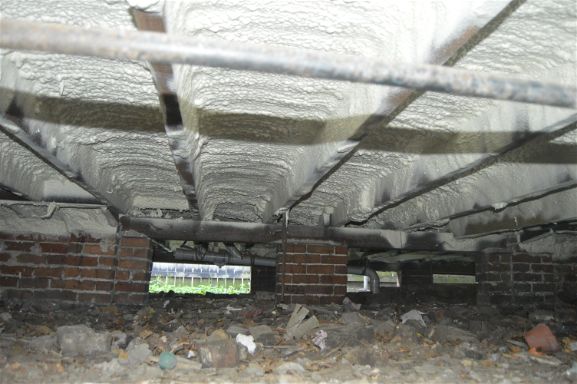Sub Floor Insulation Solves High Energy Bills
High moisture content and unwanted air flow under your house can be problematic. Whether needing sub floor insulation or a crawl space, spray foam insulation offers the solution to both areas.
Traditional fiberglass insulation doesn’t fare well in a crawl space or sub floor
Though Pete Roman resides most of the year in Lafayette, Louisiana, he still wants his vacation house in New Orleans to be comfortable and energy efficient. The old two-story home, like many historical homes in southern Louisiana, had a patchwork of insulation from a previous owner. He knew his house needed sub floor insulation to solve his problem.
Built to endure extreme heat during the days before air conditioners were common, it has large banks of windows, hardwood floors that allow air circulation, and very little insulation. While the passage of air was important before air conditioners, now these features are considered drawbacks. Keeping air cool in the South during the summer is expensive. During peak months, air conditioning accounts for half of the energy use in the United States.
To make matters worse in Roman’s case, his home’s HVAC ductwork was under his house, where it’s subject to the vagaries of the environment. When temperatures beneath the house rise, conditioned air running through the ductwork rises as well, forcing the air conditioner to perpetually re-cool the air. In addition, the old-fashioned, fiberglass sleeve fitted around the ductwork that might have reduced some of this energy waste had taken abuse from moisture and animals trifling with it.
Insulation Masters apply closed cell spray foam to ductwork
Aware of the expertise required to properly apply spray foam as well as the expense to undo poorly completed work done by amateurs, Roman did his due diligence, carefully researching local spray foam contractors. While many companies claim to be professionals, they lack the professional certifications maintained by Sunlight Contractors, LLC. Our contractors hold the highest SPFA certifications as well as being licensed with the Louisiana Licensing Board for Contractors.
Once he had established that Sunlight Contractors, LLC was the only company for the job, contractors came to his home to assess his energy needs.
“I met with Bryan to measure the space for sub floor insulation,” Roman says, “He was punctual and answered all my questions. I had several email discussions with Ira and discussed sealing the ductwork and plenum, which were in the crawl space. I received the price proposal for the added scope, which I thought was necessary to complete the insulation project. I never felt pressured to accept the added work scope. But I did add it.”
After the scope of the project was determined, contractors returned to Roman’s New Orleans home with the necessary equipment. The first step in a spray foam application is to secure the area in order to prevent homeowners or passersby from accidentally stumbling into the spray zone. While inert spray foam is harmless, during the spraying itself, it can be an irritant. Our crew wears specially designed suits to protect themselves, and they ensure the safety of others by cordoning off the space.
All of the instruments used to apply the spray foam can be found in Sunlight’s state-of-the-art rig. The spray foam is mixed in the Graco Reactor, which precisely proportions the liquids and keeps them at the correct temperature, ensuring a smooth coating. Heated hoses and spray foam guns deliver the spray foam mix to the surfaces being insulated.
In the case of Roman’s home, closed cell spray foam was applied to the underside of floorboards to seal them against air and moisture infiltration. However, closed cell spray foam’s dense, rigid consistency also improves the structural integrity of a home, strengthening the floors as it insulates.
Closed cell spray foam was also applied to the ductwork. By encapsulating the ductwork in closed cell spray foam, energy waste is reduced to a minimum. Cooled air will remain cool as it passes through the ductwork, even if temperatures outside are extreme. The sleeve of closed cell spray foam also protects the ductwork from moisture infiltration, which can encourage the buildup of mildew and mildew, and destruction by pests.
Roman was so pleased with the quality of work and the benefits gained from the initial application that he chose to encapsulate his attic. In that area, open cell spray foam is used. While open cell does air seal and insulate better than any other single product on the market, it allows the passage of water, which is important in the discovery of leaks.
A cool, comfortable home away from home with insulation
Once the work had been completed and the area cleaned up, Roman checked behind the team to make sure everything was to his satisfaction.
“I inspected the area under my house after the installation and found it to be clean of any trash from the spray foam project. The sub floor insulation was sealed and the ductwork was sealed. The work was done professionally with minimal disruption to me.”
It pays to research before hiring contractors for work as sophisticated as spray foam insulation. Done correctly, it’s a fast, easy process, and one that will provide years of comfort and savings.

